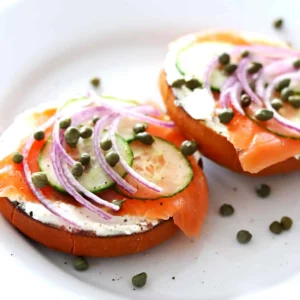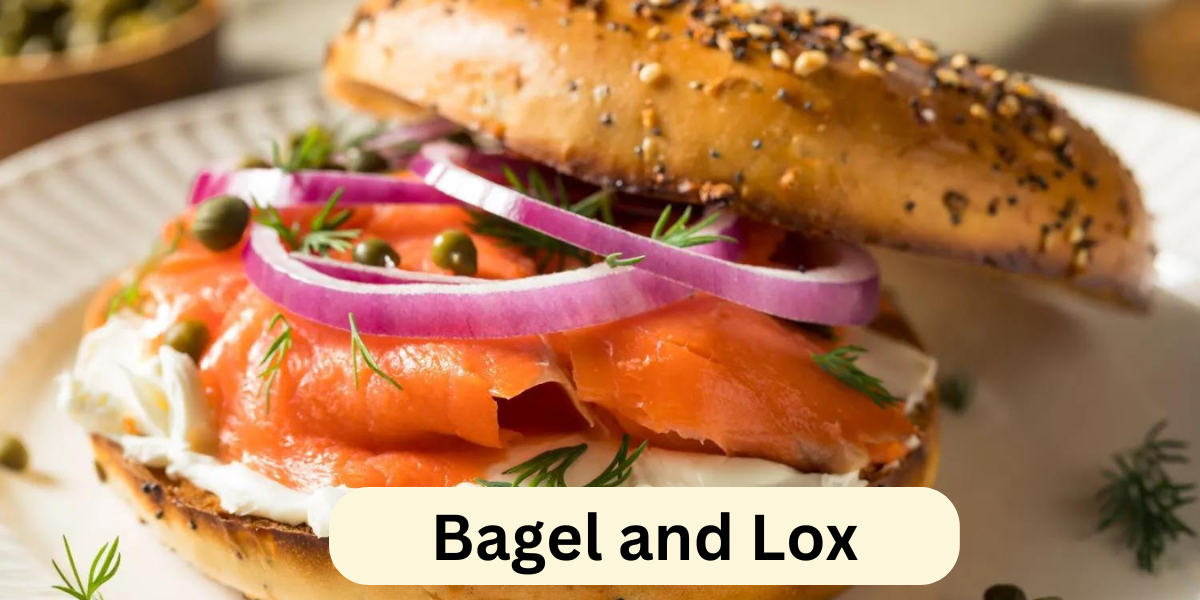Bagel and lox, a beloved combination in Jewish-American cuisine, offers a delightful blend of flavors and textures that has become a staple breakfast or brunch choice for many. This article delves into the origins of bagel and lox, the ingredients that make up this classic dish, how it’s traditionally served, and its cultural significance.
Origins of Bagel and Lox
The origins of bagel and lox can be traced back to Jewish immigrants from Eastern Europe who brought their culinary traditions to the United States in the late 19th and early 20th centuries. Bagels, originating from Poland, and lox, derived from Scandinavian cured salmon, were among the foods that became popular among Jewish communities in New York City and beyond.
The combination of bagels and lox gained prominence in the early to mid-20th century, particularly among Jewish immigrants settling in New York City, where it became a symbol of Jewish-American identity and culinary tradition.

Key Ingredients of Bagel and Lox
1. Bagel: A bagel is a ring-shaped bread roll made from yeast dough that is boiled and then baked, giving it a chewy interior and a slightly crispy crust. Traditional bagels are plain or topped with sesame seeds, poppy seeds, or everything bagel seasoning.
2. Lox: Lox refers to thinly sliced, cured salmon fillet, typically made from the belly of the fish. The salmon is cured in a brine mixture of salt, sugar, and sometimes dill, resulting in a silky texture and a mildly salty flavor. Lox is not smoked, distinguishing it from smoked salmon varieties like Nova or Scottish smoked salmon.
3. Cream Cheese: Cream cheese is a soft, spreadable cheese made from milk and cream. It serves as a creamy and tangy base for bagel and lox, complementing the flavors of the salmon and the bagel.
4. Toppings: Bagel and lox can be customized with various toppings such as thinly sliced red onion, capers, tomato slices, cucumber slices, and fresh dill. These toppings add freshness, crunch, and additional layers of flavor to the dish.

How Bagel and Lox is Served
Bagel and lox is typically served as an open-faced sandwich, with the bagel sliced horizontally and spread with a generous layer of cream cheese. Thin slices of lox are then layered on top of the cream cheese, followed by the desired toppings such as onion, capers, and dill. The other half of the bagel is placed on top to form a sandwich, creating a perfect blend of textures and flavors.
Cultural Significance
Bagel and lox holds cultural significance as a symbol of Jewish-American cuisine and heritage. It reflects the culinary adaptations and innovations of Jewish immigrants in America, combining traditional Eastern European and Scandinavian ingredients with American influences.
Beyond its cultural roots, bagel and lox has become a popular breakfast or brunch choice for people of diverse backgrounds across the United States and beyond. Its simplicity, yet rich flavors, have contributed to its enduring popularity in cafes, delis, and homes.

Variations and Innovations
While the classic combination of bagel, lox, cream cheese, and traditional toppings remains timeless, there are variations and innovations that cater to different tastes and dietary preferences:
1. Flavored Cream Cheese: Cream cheese comes in various flavors such as scallion, chive, or even smoked salmon-flavored cream cheese, adding an extra dimension of taste.
2. Bagel Varieties: Bagels now come in a wide range of flavors and varieties, including whole wheat, cinnamon raisin, and multigrain, offering options to suit different preferences.
3. Vegan and Health-Conscious Options: For those with dietary restrictions, vegan cream cheese and smoked carrot lox offer plant-based alternatives that mimic the flavors and textures of the traditional dish.
Watch Full Video:-
Making Bagel and Lox at Home
For those interested in recreating bagel and lox at home, here’s a simple recipe to get started:
Ingredients:
- 4 bagels, your choice of flavor
- 8 oz (225g) cream cheese, softened
- 8 oz (225g) lox (thinly sliced cured salmon)
- 1 small red onion, thinly sliced
- 2 tbsp capers
- 1 tomato, thinly sliced (optional)
- 1 cucumber, thinly sliced (optional)
- Fresh dill, chopped, for garnish
- Lemon wedges, for serving
Instructions:
- Slice the bagels in half horizontally and toast them lightly.
- Spread a generous amount of cream cheese on each half of the bagel.
- Layer the lox evenly over the cream cheese.
- Arrange the red onion slices, capers, and any optional toppings on top of the lox.
- Garnish with fresh dill and serve with lemon wedges on the side.

FAQs:-
1. What is lox?
Lox refers to thinly sliced, cured salmon that is brined in a mixture of salt, sugar, and sometimes dill. Unlike smoked salmon, lox is not smoked and has a silky texture with a mildly salty flavor.
2. What kind of bagel is traditionally used for bagel and lox?
Traditionally, plain or everything bagels are used for bagel and lox. However, other varieties like sesame seed or poppy seed bagels are also popular choices.
3. What is the difference between lox and smoked salmon?
Lox is cured salmon, meaning it is preserved in a salt and sugar mixture. It has a milder flavor and silkier texture compared to smoked salmon, which is exposed to smoke for additional flavor and preservation.
4. What toppings are typically served with bagel and lox?
Common toppings include thinly sliced red onion, capers, tomato slices, cucumber slices, and fresh dill. These toppings add crunch, freshness, and complementary flavors to the dish.
5. Can bagel and lox be made with any type of cream cheese?
Yes, bagel and lox can be made with various types of cream cheese, including plain, scallion, chive, or even flavored varieties like smoked salmon cream cheese.
6. Is bagel and lox considered a healthy breakfast option?
Bagel and lox can be part of a balanced breakfast, providing protein from the lox, carbohydrates from the bagel, and dairy from the cream cheese. However, portion sizes and additional toppings can affect its nutritional profile.
7. Can bagel and lox be made with vegan or vegetarian alternatives?
Yes, there are vegan and vegetarian alternatives for bagel and lox. Vegan cream cheese and plant-based alternatives for lox, such as smoked carrot lox or marinated tofu, can be used to create a plant-based version of this dish.
8. Where did bagel and lox originate?
Bagel and lox originated in Jewish-American communities, particularly in New York City, where Eastern European Jewish immigrants combined traditional ingredients like bagels and lox with local influences.
9. What are some variations of bagel and lox?
Variations include adding different types of cream cheese flavors, using alternative toppings like avocado or arugula, or incorporating additional ingredients such as scrambled eggs or spinach.
10. How should bagel and lox be stored and served?
Bagel and lox should be stored in the refrigerator if not consumed immediately. It is best served fresh, with the bagel toasted and the lox and toppings assembled just before serving for optimal taste and texture.
11. Is bagel and lox a traditional Jewish dish?
Yes, bagel and lox is considered a traditional Jewish-American dish that has become popular beyond Jewish communities due to its delicious flavors and versatility.
12. What beverages pair well with bagel and lox?
Bagel and lox pairs well with various beverages such as coffee, tea, orange juice, or even a glass of sparkling wine for brunch occasions.
Conclusion
Bagel and lox continues to be a cherished dish that reflects the culinary heritage and cultural identity of Jewish-Americans. Its simple yet flavorful combination of ingredients has made it a favorite breakfast or brunch option for generations, while adaptations and innovations have kept it relevant and beloved in contemporary cuisine. Whether enjoyed at a neighborhood deli or homemade with personalized touches, bagel and lox remains a timeless classic that celebrates tradition and taste.
ALSO READ:-Deep-Dish Pizza: A Slice of Chicago’s Culinary Heritage

